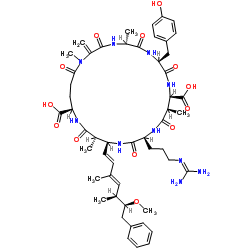Decomposition of microcystin-LR, microcystin-RR, and microcystin-YR in water samples submitted to in vitro dissolution tests.
Isabel M Moreno, Judith Maraver, Esther C Aguete, Manel Leao, Ana Gago-Martínez, Ana M Cameán
Index: J. Agric. Food Chem. 52(19) , 5933-8, (2004)
Full Text: HTML
Abstract
The presence of cyanobacterial toxins (microcystins) in waters and food increases the risk of toxicity to animal and human health. These toxins can degrade in the human gastrointestinal tract before they are absorbed. To evaluate this possible degradation, water samples spiked with known concentrations of microcystins MC-LR, MC-RR, and MC-YR, which are the toxins most commonly produced by such toxic cyanobacteria as Microcystis aeruginosa, Oscillatoria spp., and Nostoc spp., were submitted to a dissolution test that used gastric and intestinal fluids according to U.S. Pharmacopeia conditions. HPLC with UV detection was used to determine the toxins before and after treatments. This study revealed enzymatic alterations in gastric conditions for all the toxins assayed. MC-RR was the toxin most affected: its range of inactivation was 49-64%. The percentage of degradation for MC-YR and MC-LR was around 30%. However, none was degraded by intestinal digestion.
Related Compounds
| Structure | Name/CAS No. | Molecular Formula | Articles |
|---|---|---|---|
 |
microcystin yr
CAS:101064-48-6 |
C52H72N10O13 |
|
Inhibition of gap-junctional intercellular communication and...
2010-01-01 [Toxicon 55(1) , 126-34, (2010)] |
|
Highly sensitive detection and discrimination of LR and YR m...
2012-08-01 [Anal. Bioanal. Chem 404(3) , 711-20, (2012)] |
|
Comparison of the toxicity induced by microcystin-RR and mic...
2009-08-01 [Toxicon 24 , 161-169, (2009)] |
|
Method for detecting classes of microcystins by combination ...
2005-02-01 [Toxicon 45(2) , 199-206, (2005)] |
|
Characteristics of microcystin production in the cell cycle ...
2004-02-01 [Environ. Toxicol. 19(1) , 20-5, (2004)] |